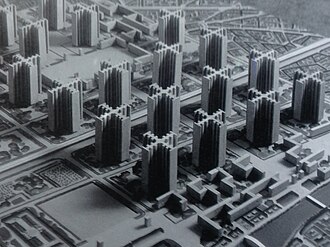Plan Voisin
The Plan Voisin was a utopian urban design by Le Corbusier , which he exhibited in 1925 in the pavilion of the magazine L'Esprit Nouveau at the " Exposition internationale des Arts Décoratifs et industriels modern " in Paris. The project, financed by the automobile and aircraft manufacturer Gabriel Voisin , envisaged the demolition of large parts of the old Parisian center on the right bank of the Seine and was therefore controversial.
Contemporary references
The young Le Corbusier was influenced, among other things, by Werner Hegemann's ideas about urban planning . He was also impressed by the concepts of Karl Scheffler , who advocated the idea of a city organized according to functions in 1913 in Die Architektur der Großstadt , and by Peter Behrens , for a time Le Corbusier's employer, who promoted high-rise buildings in the center of Berlin.
Despite his critical attitude towards Germany after the First World War, Le Corbusier continued to grapple with these ideas in the 1920s and designed a model of a “contemporary city” in 1922, which in turn led Ludwig Hilberseimer to the concept of his high-rise city.
The Voisin plan and its echo
In Plan Voisin, Le Corbusier applied the principles of his contemporary city to the center of Paris north of the Seine. In place of the grown irregularities of traditional European cities, he put 18 loosely and regularly arranged sixty-story skyscrapers with a cross-shaped floor plan. The traffic levels are separated, a wide road axis underlines the importance of individual traffic. In its architectural radicalism and lack of consideration for the historical structure, the plan generated a broad, often critical response then as now. It exerted a strong influence on the urbanistic conceptions of the 1960s and 1970s, but was also rejected as a prime example of inhuman, schematic grid architecture.
literature
- Robert Fishman: Urban Utopias in the Twentieth Century: Ebenezer Howard, Frank Lloyd Wright, Le Corbusier Basic Books, New York 1977 and MIT Books 1982 (paperback)
- Ruth Eaton: The Ideal City: From Antiquity to Modernity Nicolai, Berlin 2003
Web links
- For embedding in the contemporary discourse
- From Robert Fishman: Urban Utopias in the 20th Century
- Diploma thesis on the topic of Plan Voisin (PDF document)
- Gus Lubin: Why Architect Le Corbusier Wanted To Demolish Downtown Paris. Business Insider, August 20, 2013, accessed February 12, 2019 .
